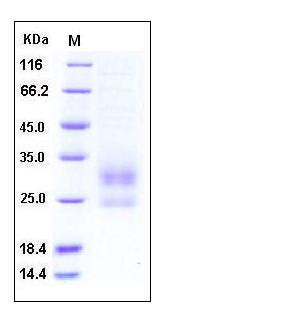Mouse LY86 / MD-1 Protein (His Tag)
MD-1,MD1
- 100ug (NPP2744) Please inquiry
| Catalog Number | P50062-M08H |
|---|---|
| Organism Species | Mouse |
| Host | Human Cells |
| Synonyms | MD-1,MD1 |
| Molecular Weight | The secreted recombinant mouse LY86 consists of 166 amino acids and has a calculated molecular mass of 18 kDa. As a result of glycosylation, the apparent molecualr mass of rmLY86 is approximately 24-30 kDa protein in SDS-PAGE under reducing conditions. |
| predicted N | Asp 20 |
| SDS-PAGE |  |
| Purity | > 92 % as determined by SDS-PAGE |
| Protein Construction | A DNA sequence encoding the extracellular domain (Met 1-Ser 162) of mouse LY86 (NP_034875.1) precursor was expressed with a C-terminal polyhistidine tag. |
| Bio-activity | |
| Research Area | Immunology |Inflammation / Inflammatory Mediator |Cells Involved in Inflammation |Monocyte/Macrophage |
| Formulation | Lyophilized from sterile PBS, pH 7.4 1. Normally 5 % - 8 % trehalose, mannitol and 0.01% Tween80 are added as protectants before lyophilization. Specific concentrations are included in the hardcopy of COA. |
| Background | MD-1 and MD-2 are secretory glycoproteins that exist on the cell surface in complexes with transmembrane proteins. MD-1 is anchored by radioprotective 105 (RP105) which is a molecule containing leucine-rich repeats and is expressed on B cells, dentritic cells and macrophages, while MD-2 is associated with TLR4. MD-1 is required for efficient RP105 cell surface expression and function. It is indicated that the RP105/MD1 complex, in conjunction with TLR4, mediates the innate immune response to LPS in B cells, and also plays a role in protecting against apoptosis, B-cell proliferation, etc. Mouse MD-1 cDNA encodes a 162 amino acid precursor protein with a putative 19 aa signal peptide and two potential N-linked glycosylation sites. It shares 40% and 66% amino acid sequence identity with chicken and human MD-1 respectively. MD-1 is mainly expressed in spleen, and also detectable in liver, brain, thymus, and kidney. |
| Reference |
